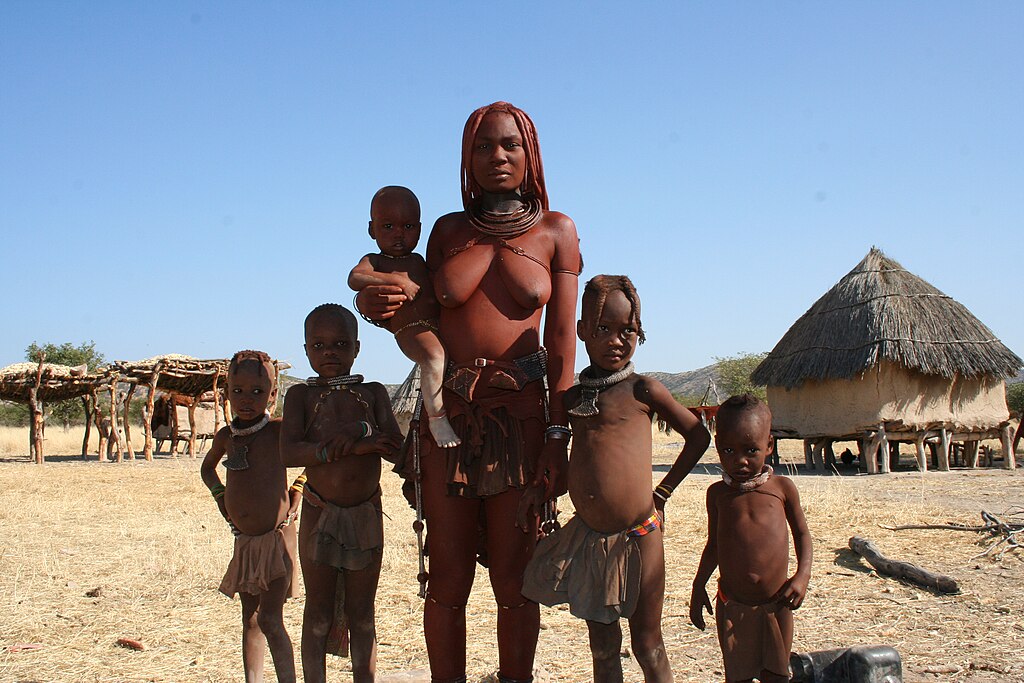The Himba people, an indigenous ethnic group living in the northwestern regions of Namibia, are one of the country’s most fascinating and resilient communities. Renowned for their distinct culture, lifestyle, and traditional practices, the Himba have managed to preserve their heritage despite the pressures of modernization and global influences. With a population of around 50,000 to 70,000, the Himba remain an essential part of Namibia’s cultural mosaic.
This article explores the unique lifestyle, traditions, and struggles of the Himba people as they continue to preserve their heritage in a rapidly changing world. It also highlights the challenges they face in maintaining their cultural identity and the efforts being made to balance tradition with the realities of modern life.
The Origins and History of the Himba People
The Himba are part of the larger Herero ethnic group, which migrated to Namibia from the Great Lakes region of central Africa several centuries ago. Their ancestral roots trace back to the Bantu-speaking communities that settled in the southern African region. The Himba’s ancestors were cattle herders, and the community has remained centered around livestock—particularly cattle—which play a significant role in their culture and economy.
The Himba people traditionally inhabit the Kunene region, located in the northwestern part of Namibia, bordering Angola. This arid and harsh environment, characterized by semi-desert terrain and extreme temperatures, has shaped the Himba’s way of life for centuries. They have adapted to their environment through nomadic pastoralism, moving from place to place in search of water and pasture for their cattle.
During the colonial era, the Himba people, like many indigenous African groups, faced pressure from European settlers. The Himba’s resistance to colonial rule was partly due to their remote location, which allowed them to preserve their traditional way of life. However, they were still impacted by colonial policies that sought to undermine their self-sufficiency and cultural practices.
Today, the Himba are a symbol of cultural resilience—they have retained much of their traditional lifestyle while navigating the complexities of modern-day Namibia.
The Himba Way of Life: A Glimpse into Tradition
The Himba people are known for their distinctive appearance and rich cultural practices that continue to fascinate visitors and researchers alike. Their way of life is deeply rooted in spirituality, community, and tradition, with cattle being central to their identity.
1. Livestock and Cattle: The Heart of Himba Culture
Cattle are central to the Himba lifestyle, representing wealth, status, and social harmony. A Himba family’s wealth is measured by the number of cattle they own, and the herd plays an essential role in the community’s rituals and ceremonies. Bride prices in Himba culture are traditionally paid with cattle, and animal sacrifices are performed to honor ancestors and ensure the well-being of the community.
Cattle also provide milk, meat, and skins, which are used for various purposes. The Himba’s survival in a harsh environment is intricately tied to their ability to manage and care for their herds. They use traditional herding methods passed down through generations to ensure that the cattle thrive in the dry and often unforgiving climate of the Kunene region.
2. Traditional Clothing and Beauty Practices
One of the most striking features of Himba culture is their distinctive attire and beauty practices, which serve both cultural and functional purposes. Himba women are famous for their ochre-covered skin, a result of their unique beauty ritual. Red ochre mixed with butterfat is applied to the skin and hair to protect them from the harsh desert sun, as well as to maintain moisture and smoothness in their skin. This practice also has symbolic meanings related to fertility, protection, and beauty. The Himba also use herbal oils for cosmetic and medicinal purposes.
Himba women wear traditional clothing made from animal skins, and adorn themselves with elaborate jewelry, including necklaces, bracelets, and headpieces made of beads, shells, and copper. The attire is not only functional, as it offers protection from the sun and sand, but it also represents cultural identity and social status. Married women wear specific headdresses, called “Eembe”, to symbolize their marital status.
For the Himba, beauty is deeply intertwined with cultural identity and social roles. The practice of beautifying oneself is also a rite of passage, with young girls transitioning into adulthood through a series of traditional rituals, including the “Ukuleka” (initiation ceremony).
3. The Role of Religion and Spirituality
The Himba believe in a spiritual world and practice a monotheistic religion, worshipping a god known as Mukuru. This god is believed to be the creator of the universe and the source of all life. Himba religious practices are closely linked to their daily lives, with rituals conducted to honor ancestors, seek blessings for their cattle, and ensure the health and prosperity of the community.
The Himba people maintain strong ties with their ancestors, who are believed to watch over them and offer guidance. This connection is reinforced through sacrifices and rituals, where animals are slaughtered as offerings. These rituals are typically led by the chiefs or spiritual leaders of the community, who hold significant authority in maintaining cultural practices.
Traditional healers or herbalists also play an important role in the community, using indigenous plants and remedies to treat various ailments. Their knowledge is passed down through generations and is crucial for the well-being of the Himba people in their challenging environment.
Modern Challenges Facing the Himba People
Despite their strong cultural traditions, the Himba people face a host of challenges brought about by the pressures of modernity and the changing political landscape of Namibia. As the world becomes more interconnected and urbanized, the Himba find themselves at a crossroads—balancing the need to preserve their heritage with the need to adapt to new technologies and opportunities.
1. Climate Change and Environmental Pressures
One of the most immediate challenges the Himba face is the impact of climate change on their traditional lifestyle. The Kunene region is already one of the most arid parts of Namibia, and the increasing unpredictability of rainfall and prolonged periods of drought are making it harder for the Himba to maintain their cattle herds. Water scarcity is a critical issue, as the Himba rely on seasonal rains to feed their herds and grow crops. With shrinking resources, there are fears that climate change could lead to food insecurity and displacement in the future.
Additionally, land disputes and conflicts with other ethnic groups over resources have exacerbated the challenges faced by the Himba. Their traditional nomadic lifestyle makes it harder to claim ownership of land, and government policies that encourage sedentarization threaten their ability to maintain their traditional ways of life.
2. Pressure from Tourism and Globalization
The Himba people have become a popular subject of interest for tourists, who visit their villages to experience their unique culture. While tourism has brought in some revenue, it has also introduced new challenges. Cultural commodification—where traditional practices are altered to suit the expectations of tourists—has become a concern. The Himba are increasingly faced with the dilemma of how much of their culture should be shared with outsiders, while still maintaining its authenticity.
Moreover, globalization has brought modern technologies, including smartphones, internet access, and social media, which are changing the way younger generations of Himba engage with their traditions. While these tools provide new opportunities for education and connectivity, they also pose a threat to the preservation of traditional knowledge and lifestyles.
3. Government Policies and Education
Another significant challenge is the Himba’s integration into Namibia’s national education system. While education is a fundamental right in Namibia, many Himba children have limited access to schooling, especially in rural areas. Additionally, the education system often prioritizes formal schooling over traditional knowledge, leading to concerns that Himba youth may lose their cultural identity as they adapt to urban life.
Government policies aimed at infrastructure development, settlement programs, and education are often seen as intrusive by the Himba, as they may force them to abandon their traditional lifestyles. There are also concerns that Himba youth may be drawn away from rural areas to cities in search of better job prospects, which could further erode traditional practices.
Efforts to Preserve Himba Heritage
Despite these challenges, the Himba people remain committed to preserving their heritage and adapting to modern life without losing their cultural identity. Various community-based initiatives and NGOs are working with the Himba to address issues such as education, healthcare, and sustainable development, while respecting their traditional ways of life.
In some areas, the Himba have embraced sustainable practices that help mitigate the effects of climate change, such as rainwater harvesting, herd management techniques, and eco-tourism. These efforts are aimed at balancing the needs of the community with the preservation of their environment.
Furthermore, younger Himba are beginning to use modern technology, such as smartphones and social media, to document and share their culture with the wider world while maintaining their traditional values. Many are also seeking ways to combine modern education with traditional knowledge, ensuring that the next generation has the tools to thrive in both the digital and physical worlds.
The Himba people of Namibia represent a remarkable example of cultural resilience in the face of modernization. Their commitment to preserving their traditions, language, and way of life in an increasingly globalized world is a testament to their strength and determination. While they face many challenges, including climate change, tourism pressures, and the need for modern education, the Himba continue to find ways to adapt while remaining true to their heritage.
As Namibia moves forward into the future, it is essential that efforts continue to support the Himba in preserving their cultural identity, ensuring that their unique traditions are not lost in the face of global change. The Himba people’s journey offers valuable lessons about the importance of heritage, resilience, and sustainability in an ever-changing world.













